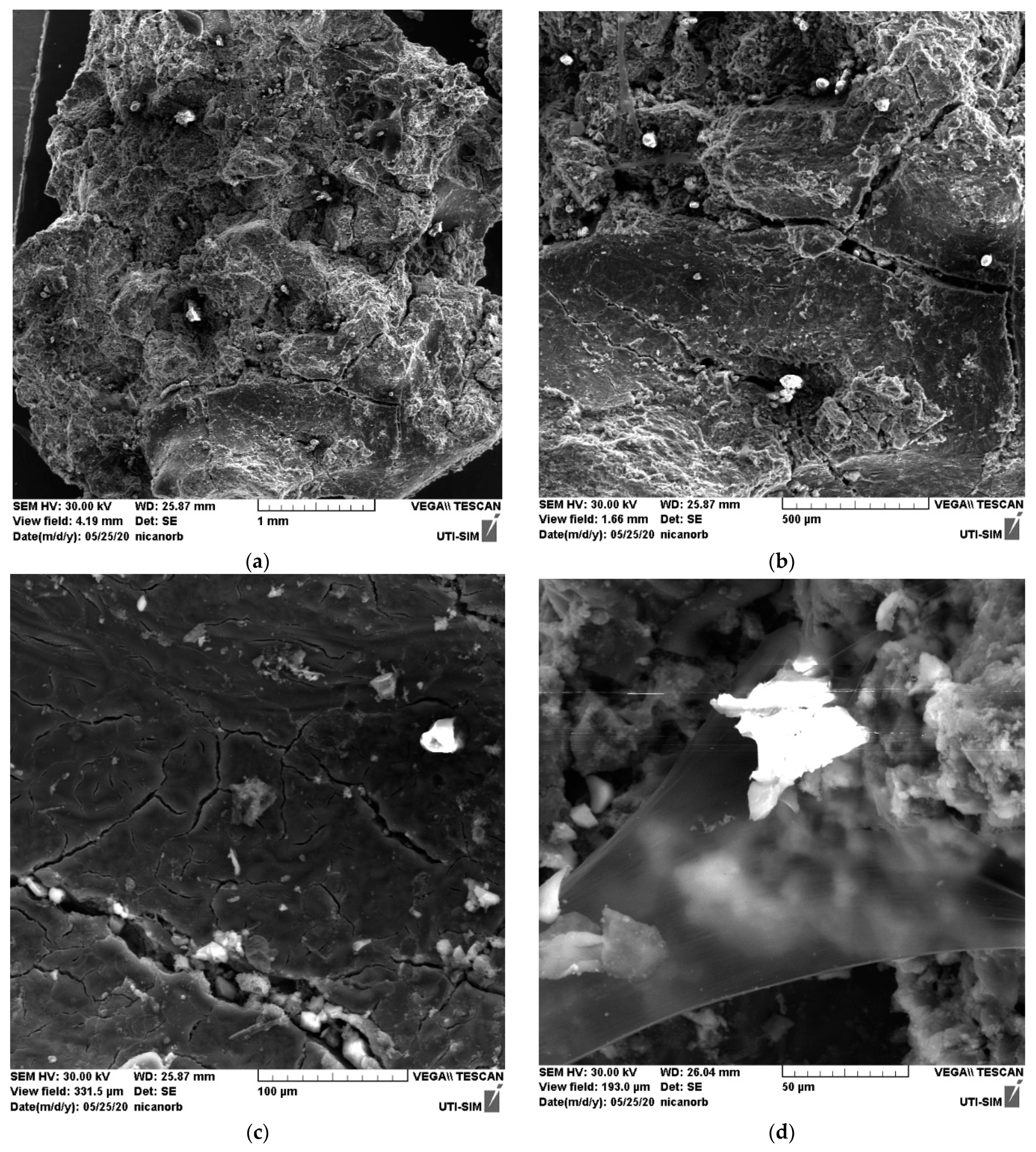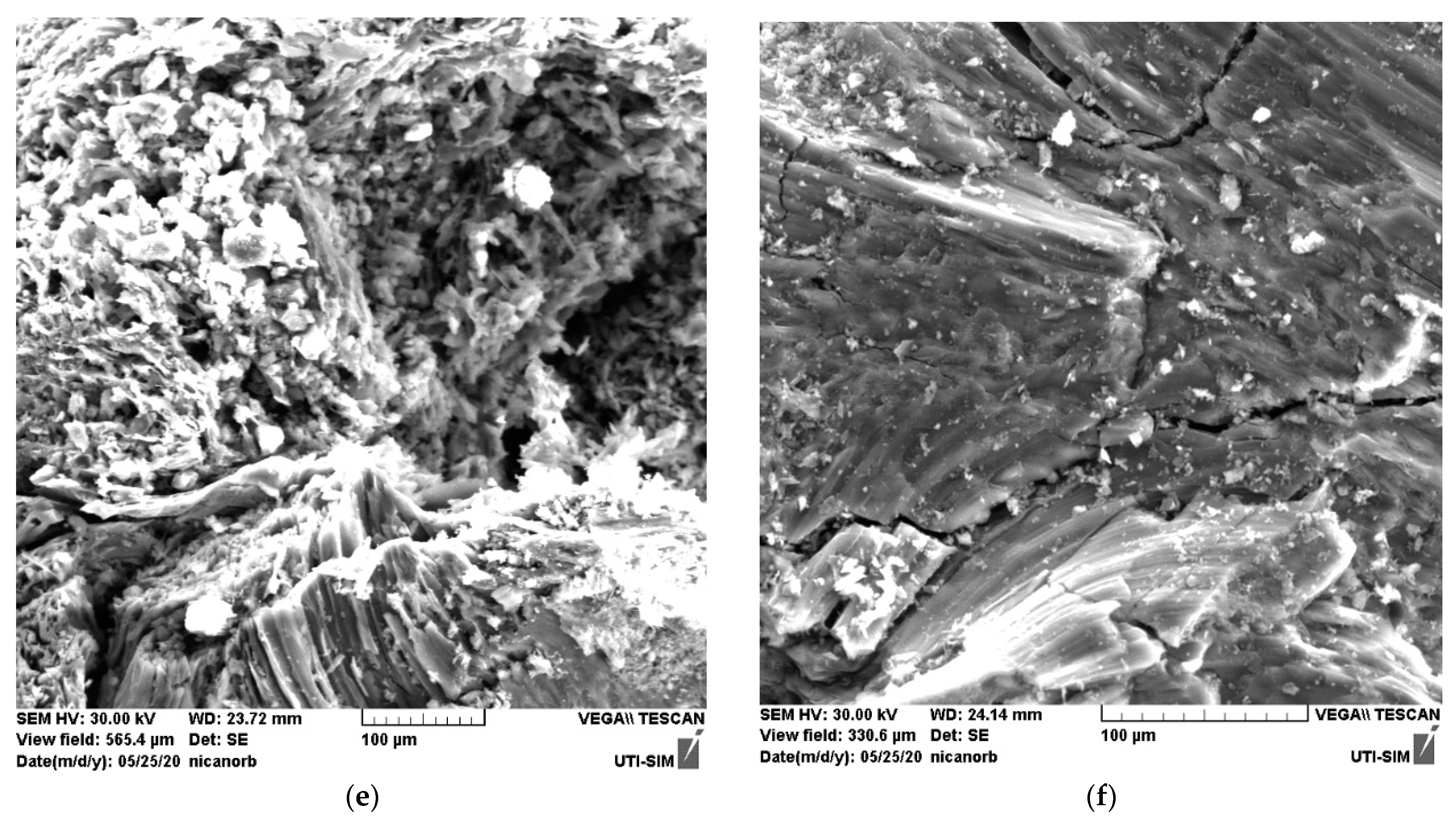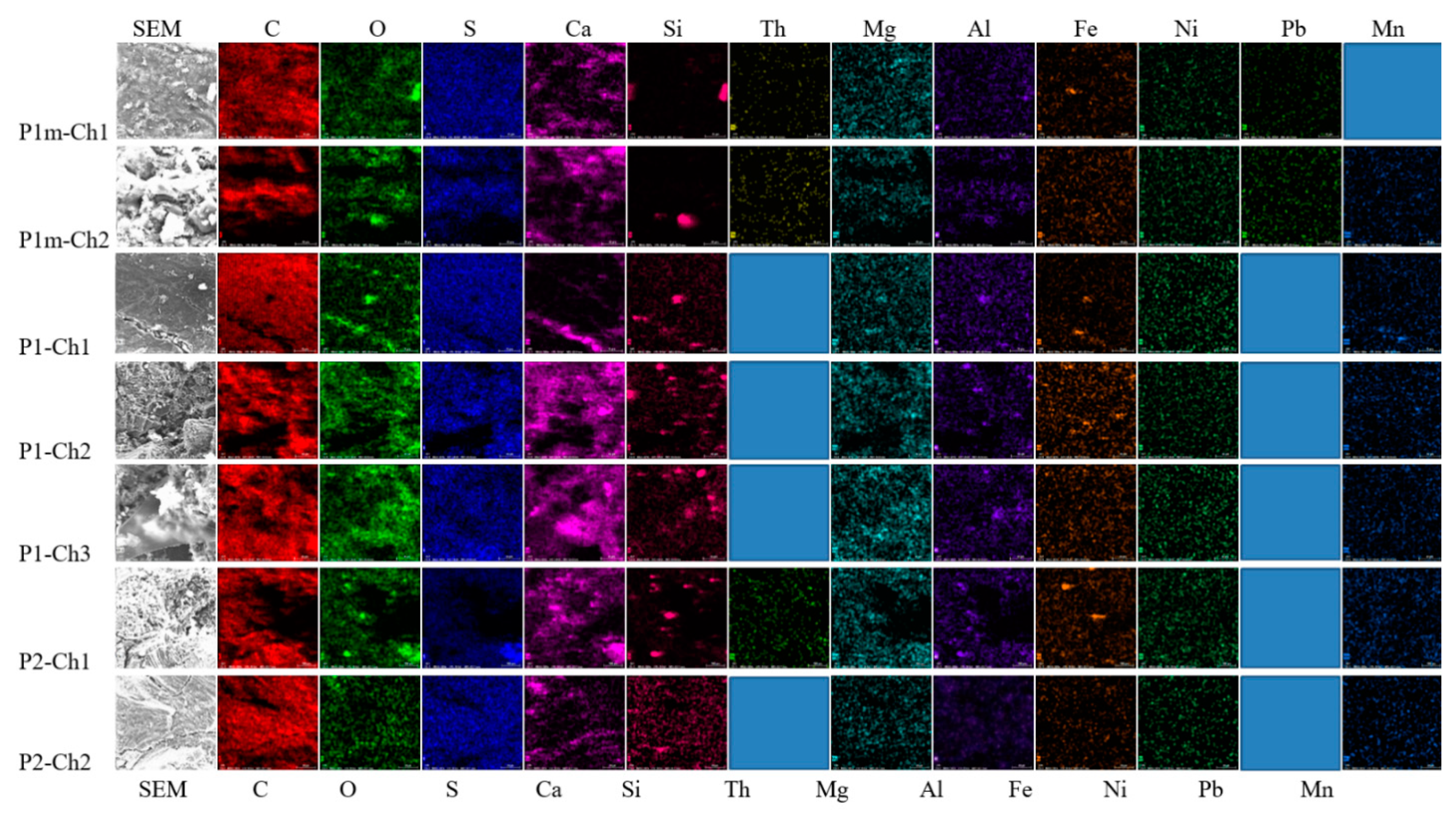The Origin and Physico-Chemical Properties of Some Unusual Earth Rock Fragments
Abstract
:1. Introduction
2. Materials and Methods
3. Results and Discussions
3.1. Solubility and Density
3.2. FTIR Spectra Analysis
- ➢
- Carboxylic acids and/or amino acids (also in the Murchison and Bells carbonaceous chondrite meteorites);
- ➢
- Amines, amides I and II;
- ➢
- Aliphatic (also in the Murchison and Bells carbonaceous chondrite meteorites) and aromatic compounds (also in the Bells carbonaceous chondrite meteorite);
- ➢
- Fullerenes (also in the Allende carbonaceous chondrite meteorite);
- ➢
- Carbonates (also in the Murchison and Bells carbonaceous chondrite meteorites) as calcium carbonate in a crystalline state = calcite (the strong peak at 1429 and 1438 cm−1;
- ➢
- Sulfates (also in the Murchison and Bells carbonaceous chondrite meteorites) as calcium sulfate (CaSO4 and FeSO4) and sulfites as calcium sulfite (CaSO3);
- ➢
- Thorium oxides (Th IV);
- ➢
- Silicates (also in the Murchison and Bells carbonaceous chondrite meteorites) and silanol groups (Si–OH) as terminal groups bonded to the polymeric chain;
- ➢
- Adsorbed water free molecules and H-bonded (also in the Murchison and Bells carbonaceous chondrite meteorites);
- ➢
- Absorbed and structural water in hydrous silicates (also in the Murchison and Bells carbonaceous chondrite meteorites);
- ➢
- Adsorbed carbon dioxide (CO2) on the fragments’ surface;
- ➢
- Sulfur may also be included in the organic compounds as sulfones and sulfoxides;
- ➢
- The shape of the baseline of the two FTIR spectra that drops off at both edges indicates a scattering effect, due to crystalline structures. (See the bands at 1429 cm−1 in P1 and at 1438 cm−1 in P2). The shift of the peak between the two samples is due to the influence of the other two crystalline components in sample P1 (SiO2—moganite and CaSO4—anhydrite) to the specific vibration of crystalline CaCO3, compared with sample P2 where only crystalline CaCO3 (calcite) was detected by XRD.
3.3. Crystallinity Analysis from XRD
3.4. Elemental Composition Analyzed with Energy Dispersive Spectroscopy (EDS)
3.5. Petrography
3.5.1. Optical Microscopy Images
3.5.2. Surface Morphology Analyzed with Scanning Electron Microscopy (SEM)
3.5.3. Maps of Elements
4. Conclusions
Author Contributions
Funding
Acknowledgments
Conflicts of Interest
References
- Hyman, H.; Fegley, B.; Prinn, R.G.; Lewis, J.S. Carbonaceous chondrites and the origin of life. LPI Contrib. 1982, 497, 36. [Google Scholar] [CrossRef]
- Callahan, M.P.; Smith, K.E.; Cleaves II, H.J.; Ruzickad, J.; Sterna, C.J.; Glavina, D.P.; House, C.H.; Dworkina, J.P. Carbonaceous meteorites contain a wide range of extraterrestrial nucleobases. Proc. Natl. Acad. Sci. USA 2011, 108, 13995–13998. [Google Scholar] [CrossRef] [PubMed] [Green Version]
- Glavin, D.P.; Alexander, C.M.D.; Aponte, J.C.; Dworkin, J.P.; Elsila, J.E.; Yabuta, H. The Origin and Evolution of Organic Matter in Carbonaceous Chondrites and Links to Their Parent Bodies. In Primitive Meteorites and Asteroids; Abreu, N., Ed.; Elsevier: Amsterdam, The Netherlands, 2018; pp. 205–271. [Google Scholar] [CrossRef]
- Sephton, M.A. Organic matter in ancient meteorites. Astron. Geophys. 2004, 45, 2.8–2.14. [Google Scholar] [CrossRef] [Green Version]
- Endreß, M.; Bischoff, A. Carbonates in CI chondrites: Clues to parent body evolution. Geochim. Cosmochim. Acta 1996, 60, 489–507. [Google Scholar] [CrossRef]
- Lee, M.R.; Ellen, R. Aragonite in the Murray (CM2) carbonaceous chondrite: Implications for parent body compaction and aqueous alteration. Meteorit. Planet. Sci. 2008, 43, 1219–1231. [Google Scholar] [CrossRef]
- Kebukawa, Y.; Kobayashi, H.; Urayama, N.; Baden, N.; Kondo, M.; Zolensky, M.E.; Kobayashi, K. Nanoscale infrared imaging analysis of carbonaceous chondrites to understand organic-mineral interactions during aqueous alteration. Proc. Natl. Acad. Sci. USA 2019, 116, 753–758. [Google Scholar] [CrossRef] [PubMed] [Green Version]
- Pizzarello, S.; Shock, E. The Organic Composition of Carbonaceous Meteorites: The Evolutionary Story Ahead of Biochemistry. Cold Spring Harb. Perspect. Biol. 2010, 2, a002105. [Google Scholar] [CrossRef] [PubMed]
- Becker, L.; Poreda, R.J.; Nuth, J.A.; Ferguson, F.T.; Liang, F.; Billups, W.E. Fullerenes in Meteorites and the Nature of Planetary Atmospheres. In Natural Fullerenes and Related Structures of Elemental Carbon. Developments in Fullerene Science; Rietmeijer, F.J.M., Ed.; Springer: Berlin/Heidelberg, Germany, 2006. [Google Scholar] [CrossRef]
- Guaita, C. SEM exploration of carbonaceus chondrites. Mem. Della Soc. Astron. Ital. Suppl. 2012, 20, 74. [Google Scholar]
- Kööp, L.; Heck, P.R.; Busemann, H.; Davis, A.M.; Greer, J.; Maden, C.; Meier, M.M.M.; Wieler, R. High early solar activity inferred from helium and neon excesses in the oldest meteorite inclusions. Nat. Astron. 2018, 2, 709–713. [Google Scholar] [CrossRef]
- Bate, L.; Huizenga, J.R.; Potratz, H.A. Thorium in stone meteorites by neutron activation analysis. Geochim. Cosmochim. Acta 1959, 16, 88–100. [Google Scholar] [CrossRef]
- Lovering, J.F.; Morgan, J.W. Uranium and thorium abundances in stony meteorites: 1. The chondritic meteorites. J. Geophys. Res. 1964, 69, 1979–1988. [Google Scholar] [CrossRef]
- Matsumoto, M.; Tsuchiyama, A.; Nakato, A.; Matsuno, J.; Miyake, A.; Kataoka, A.; Ito, M.; Tomioka, N.; Kodama, Y.; Uesugi, K.; et al. Discovery of fossil asteroidal ice in primitive meteorite Acfer 094. Sci. Adv. 2019, 5, eaax5078. [Google Scholar] [CrossRef] [Green Version]
- Coulson, S.G.; Wallis, M.K.; Wickramasinghe, N.C. On the dynamics of volatile meteorites. Mon. Not. R. Astron. Soc. 2014, 445, 3669–3673. [Google Scholar] [CrossRef] [Green Version]
- Haack, H.; Grau, T.; Bischoff, A.; Horstmann, M.; Wasson, J.; Sørensen, A.; Laubenstein, M.; Ott, U.; Palme, H.; Gellissen, M.; et al. Maribo—A new CM fall from Denmark. Meteorit. Planet. Sci. 2011, 47, 30–50. [Google Scholar] [CrossRef]
- Martins, Z.; Chan, Q.H.S.; Bonal, L.; King, A.; Yabuta, H. Organic Matter in the Solar System—Implications for Future on-Site and Sample Return Missions. Space Sci. Rev. 2020, 216, 54. [Google Scholar] [CrossRef]
- Bradley, J.P. Early Solar Nebula Grains—Interplanetary Dust Particles. In Treatise on Geochemistry, 2nd ed.; Holland, H.D., Turekian, K.K., Eds.; Elsevier: Amsterdam, The Netherlands, 2014; pp. 287–308. [Google Scholar]
- Dartois, E.; Engrand, C.; Duprat, J.; Godard, M.; Charon, E.; Delauche, L.; Sandt, C.; Borondics, F. Dome C ultracarbonaceous Antarctic micrometeorites Infrared and Raman Õngerprints. Astron. Astrophys. 2018, 609, A65. [Google Scholar] [CrossRef]
- Cocean, A.; Cocean, I.; Cimpoesu, N.; Cocean, G.; Cimpoesu, R.; Postolachi, C.; Popescu, V.; Gurlui, S. Laser Induced Method to Produce Curcuminoid-Silanol Thin Films for Transdermal Patches Using Irradiation of Turmeric Target. Appl. Sci. 2021, 11, 4030. [Google Scholar] [CrossRef]
- Pretch, E.; Bülmann, P.; Badertscher, M. Structure Determination of Organic Compounds, 4th ed.; Springer: Berlin/Heidelberg, Germany, 2009. [Google Scholar] [CrossRef]
- van den Boom, A.F.J.; Pujari, S.P.; Bannani, F.; Driss, H.; Zuilhof, H. Fast room-temperature functionalization of silicon nanoparticles using alkyl silanols. Faraday Discuss. 2020, 222, 82–94. [Google Scholar] [CrossRef] [PubMed]
- Miller, F.A.; Wilkins, C.H. Infrared Spectra and Characteristic Frequencies of Inorganic Ions. Their Use in Qualitative Analysis. Anal. Chem. 1952, 24, 1253–1294. [Google Scholar] [CrossRef]
- Wu, H.J.; Goodwin, D.G., Jr.; Peter, K.; Benoit, D.; Li, W.; Fairbrother, D.H.; Fortner, J.D. Photo-Oxidation of Hydrogenated Fullerene (Fullerane) in Water. Environ. Sci. Technol. Lett. 2014, 1, 490–494. [Google Scholar] [CrossRef]
- Israel, F.P. Light on Dark Matter; Springer: Berlin/Heidelberg, Germany, 1986. [Google Scholar]
- Cocean, I.; Cocean, A.; Postolachi, C.; Pohoata, V.; Cimpoesu, N.; Bulai, G.; Iacomi, F.; Gurlui, S. Alpha keratin amino acids behvior under high fluence laser interaction. Medical applications. Appl. Surf. Sci. 2019, 488, 418–426. [Google Scholar] [CrossRef]
- Hospodarova, V.; Singovszka, E.; Stevulova, N. Characterization of Cellulosic Fibers by FTIR Spectroscopy for Their Further Implementation to Building Materials. Am. J. Anal. Chem. 2018, 9, 303–310. [Google Scholar] [CrossRef] [Green Version]
- Andersen, F.A.; Brecevic, L. Infrared of amorphous and Crystalline Calcium Carbonate. Acta Chem. Scand. 1991, 45, 1018–1024. [Google Scholar] [CrossRef]
- Cai, G.-B.; Chen, S.-F.; Liu, L.; Jiang, J.; Yao, H.-B.; Xu, A.-W.; Yu, S.-H. 1,3-Diamino-2-hydroxypropane-N,N,N′,N′-tetraacetic acid stabilized amorphous calcium carbonate: Nucleation, transformation and crystal growth. CrystEngComm 2010, 12, 234–241. [Google Scholar] [CrossRef]
- Alves, G.C.; Ladeira, L.O.; Righi, A.; Krambrock, K.; Calado, H.D.; Pereira de Freitas Gil, R.; Pinheiro, M.V.B. Synthesis of C60(OH)18-20 in Aqueous Alkaline Solution Under O2-Atmosphere. J. Braz. Chem. Soc. 2006, 17, 1186–1190. [Google Scholar] [CrossRef] [Green Version]
- Bőkea, H.; Akkurtb, S.; Őzdemirb, S.; Gőktȕrkc, E.H.; Saltikd, E.N.C. Quantification of CaCO3–CaSO3•0.5H2O–CaSO4•2H2O mixtures by FTIR analysis and its ANN mode. Mater. Lett. 2004, 58, 723–726. [Google Scholar] [CrossRef] [Green Version]
- Ali, M.; Aslani, A.; Celik, F.; Mermer, O.; Aslani, C.K. Assessment of reaction between thorium and polyelectrolyte nano-thin film using Box–Behnken design. Adsorpt. Sci. Technol. 2018, 36, 586–607. [Google Scholar] [CrossRef] [Green Version]
- Mohlenhoff, B.; Romeo, M.; Diem, M.; Woody, B.R. Mie-Type Scattering and Non-Beer-Lambert Absorption Behavior of Human Cells in Infrared Microspectroscopy. Biophys. J. Vol. 2005, 88, 3635–3640. [Google Scholar] [CrossRef] [PubMed] [Green Version]
- Khenfouch, M.; Buttner, U.; Baïtoul, M.; Maaza, M. Synthesis and Characterization of Mass Produced High Quality Few Layered, Graphene Sheets via a Chemical Method. Graphene 2014, 3, 7–13. [Google Scholar] [CrossRef] [Green Version]
- Hutchison, R. Meteorites: A Petrologic, Chemical and Isotopic Synthesis; Cambridge University Press: Cambridge, UK, 2004. [Google Scholar]
- Weisberg, M.K.; McCoy, T.J.; Krot, A.N. Systematics and Evaluation of Meteorite Classification. In Meteorites and the Early Solar System II; Lauretta, D.S., McSween, H.Y., Jr., Eds.; The University of Arizona Press: Tucson, AZ, USA, 2006; p. 34. [Google Scholar]








| Sample | VT [mL] | VH2O [mL] | VP = VT − VH2O [mL] | M [g] | ρ = M/VP [g/cm3] | VT [mL] |
|---|---|---|---|---|---|---|
| P1 | 53.08 | 40 | 13.08 | 13.573 | 1.037 | 70 |
| P2 | 70 | 46.16 | 23.84 | 20.30 | 0.851 | 0.535 |
| ρav = ρ1/ρ2 [g/cm3] | 0.944 |
| Vibration Bands in the Sample Spectra [cm−1] | Functional Groups | In Meteorites | |
|---|---|---|---|
| P1 | P2 | ||
| 3805 | 3805 |
| * |
| 3750 (sharp) | 3750 (doublet) | * | |
| 3545 | 3545 (doublet) |
| * |
| 3425 | 3425 |
| Murchison Meteorite: ∼3400 and 1640 cm−1, and are assigned to structural and/or absorbed H2O of hydrous silicates Bells Meteorite: 3400 cm−1 corresponding to OH [7] |
| 3382 | 3382 |
| * |
| 3306; 3252 | 3317; 3252 |
| * |
| 3121 | 3121 | * | |
| * | 3056 |
| * |
| 2839 | 2860 | Murchison Meteorite: 2960, 2930, and 2860 cm−1; assigned to the aliphatic C–H stretching modes Bells Meteorite: 2950 cm−1 assigned to aliphatic C–H [7] Fullerenes identified in Murchison and Allende carbonaceous chondrite meteorites [9]; | |
| 2764 | 2764 |
| Fullerenes identified in Murchison and Allende carbonaceous chondrite meteorites [9] |
| 2340 | 2361 |
| * |
| * | * | * | Murchison Meteorite: 1730 cm−1 corresponding to C=O Bells Meteorite: ∼1730 cm−1 assigned to C=O [7] |
| 1905-1699 | 1905-1699 |
| * |
| 1656 | 1656 |
| Murchison Meteorite: at ∼3400 and 1640 cm−1, and are assigned to structural and/or absorbed H2O of hydrous silicates [7] |
| 1536 | * | Bells Meteorite: ∼1600 cm−1 assigned to aromatic C=C [7] | |
| 1429 | 1438 | Murchison Meteorite: around 1435 cm−1; assigned to CO32− of carbonates Bells Meteorite: 1450 cm−1 assigned to carbonates [7] 1453 [30] CH2 deformation mode in CH2–C=C [20] | |
| * | 1093 | Murchison Meteorite: 1150 cm−1; assigned to SO42− of sulfates Bells Meteorite: 1124 cm−1 corresponding to sulfates [7] | |
| 950 853; 804 | 950 830; 804 |
| Murchison Meteorite: around 1000 cm−1, assigned to the Si–O stretching modes of silicates Bells Meteorite: silicate peaks at around 1000 cm−1; 1010 cm−1 corresponding to SiO [7] |
| 874 | 874 | * | |
| (900-650) 734 | (900-650) 734 |
| * |
| 650 | 650 |
| * |
| 669; 661 | 669; 661 |
| * |
| (874-689) 689 | (874-689) 689 |
| * |
| 689 | 689 | * | |
| 612 | 611 |
| * |
| 597 | 597 | * | |
| Element | Atom [%] | ||
|---|---|---|---|
| s1 | s2 | s3 | |
| Carbon | 85.9724 | 77.7475 | 80.3783 |
| Oxygen | 12.1562 | 20.4560 | 17.0068 |
| Sulfur | 1.4799 | 0.8755 | 0.5528 |
| Calcium | 0.3714 | 0.4666 | 1.6246 |
| Silicon | • | 0.2580 | 0.2675 |
| Thorium | 0.0025 | 0.0117 | 0.0052 |
| Magnesium | 0.0065 | 0.0927 | 0.0823 |
| Aluminum | • | 0.0542 | 0.0398 |
| Iron | 0.0045 | 0.0242 | 0.0229 |
| Nickel | 0.0066 | 0.0137 | 0.0104 |
| Lead | • | 0.0009 | • |
| Manganese | • | • | 0.0093 |
| 100 | 100 | 100 | |
Publisher’s Note: MDPI stays neutral with regard to jurisdictional claims in published maps and institutional affiliations. |
© 2022 by the authors. Licensee MDPI, Basel, Switzerland. This article is an open access article distributed under the terms and conditions of the Creative Commons Attribution (CC BY) license (https://creativecommons.org/licenses/by/4.0/).
Share and Cite
Cocean, A.; Postolachi, C.; Cocean, G.; Bulai, G.; Munteanu, B.S.; Cimpoesu, N.; Cocean, I.; Gurlui, S. The Origin and Physico-Chemical Properties of Some Unusual Earth Rock Fragments. Appl. Sci. 2022, 12, 983. https://doi.org/10.3390/app12030983
Cocean A, Postolachi C, Cocean G, Bulai G, Munteanu BS, Cimpoesu N, Cocean I, Gurlui S. The Origin and Physico-Chemical Properties of Some Unusual Earth Rock Fragments. Applied Sciences. 2022; 12(3):983. https://doi.org/10.3390/app12030983
Chicago/Turabian StyleCocean, Alexandru, Cristina Postolachi, Georgiana Cocean, Georgiana Bulai, Bogdanel Silvestru Munteanu, Nicanor Cimpoesu, Iuliana Cocean, and Silviu Gurlui. 2022. "The Origin and Physico-Chemical Properties of Some Unusual Earth Rock Fragments" Applied Sciences 12, no. 3: 983. https://doi.org/10.3390/app12030983
APA StyleCocean, A., Postolachi, C., Cocean, G., Bulai, G., Munteanu, B. S., Cimpoesu, N., Cocean, I., & Gurlui, S. (2022). The Origin and Physico-Chemical Properties of Some Unusual Earth Rock Fragments. Applied Sciences, 12(3), 983. https://doi.org/10.3390/app12030983








